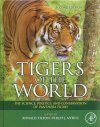![Tigers of the World Tigers of the World]()
Click to have a closer look
About this book
Customer reviews
Related titles
About this book
The second edition of Tigers of the World explores tiger biology, ecology, conservation, management, and the science and technology that make this possible. In 1988 when the first edition was published, tiger conservation was still in its infancy, and two decades later there has been a revolution not only in what is known, but how information about tigers is obtained and disseminated.
In the fast changing world of conservation there is a great need to summarize the vast and current state-of-the-art, to put this into historical perspective, and to speculate in what yet remains to be done. Tigers of the World, 2nd Edition fulfills this need by bringing together in a unique way the world's leading tiger experts into one volume. Despite the challenges ahead, there are bright spots in this story, and lessons aplenty not only for tiger specialists but large carnivore specialists, conservation biologists, wildlife managers, natural resource policy makers, and most importantly the caring public. It is through broad public understanding and support - in Asia, North America, and Europe - that will have the greatest impact on tigers over the long term.With this in mind, the book is novel in its presentation of information using images, indigenous art and poetry, anecdotes, maps and other images to engage and inform. Side bars and text boxes focus on important concepts and debates and help to balance different perspectives and opinions. There is no other book which equally benefits both the scientific and general audiences.
Customer Reviews
Edited By: Ronald Tilson and Philip J Nyhus
524 pages, Col & b/w figs
Ron Tilson, director of conservation at Minnesota Zoo, co-author of a new edition of the encyclopedic Tigers of the World and, with decades of fieldwork in Asia's tiger habitats under his belt, [is] an authority - maybe the authority - on our most endangered big cat.-"Tale of the Cat" by Andrew Marshall (Time magazine) "An excellent follow-up to the 1987 publication. The 102 contributors represent a broad panel of distinguished international researchers. [E]ach chapter's terminology and research descriptions are layperson-friendly. There is very little repetition between the two editions; the first focused heavily on tigers in captivity, while the second emphasizes wild tiger conservation, history, economics, and political battles. Highly recommended. Academic, general, and professional audiences, all levels. -- CHOICE "Some of the world's most eminent researchers confirm this in a new academic book, Tigers of the World. In it Ronald Tilson, an expert at Minnesota Zoo, reveals he attended a meeting in Beijing where Chinese scientists admitted that their captive "pure-bred" South China tigers were anything but. He wrote: "A Chinese molecular biologist, Daniel Xu, presented the surprising conclusions that no 'pure' South China tiger lineages are left living; all living captive tigers are mixed with Indochinese tiger genes." -- The Sunday Times "Tilson, who is probably best known for his work with tigers, wrote the book on tiger conservation -- literally. "Tigers of the World," published in 1988 and updated last year, "put together in one volume, for the first time, the state of science about tigers," said Phillip Nyhus, professor of environmental studies at Colby University in Maine.































